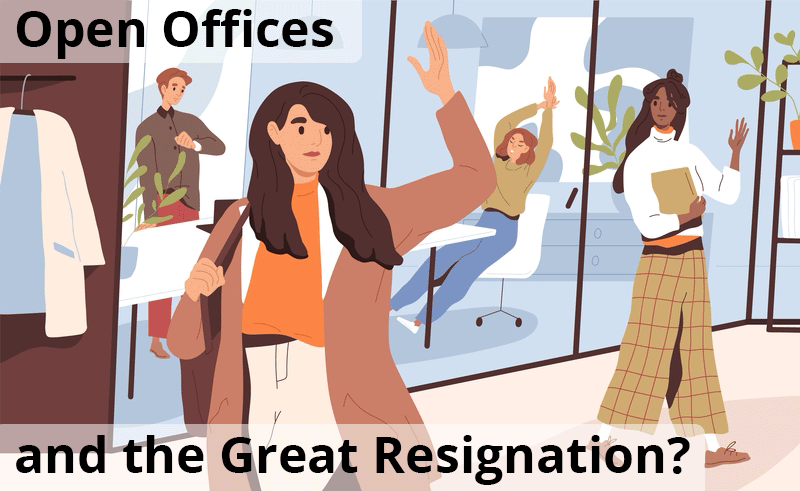Few workplace design topics are as divisive as the debate between open offices and more traditional offices. Data suggests that open offices are an overwhelming success, with 89% of the highest performing workplaces having an open floor plan and companies that implement them routinely winning “Best Place to Work” awards.
But at the same time, they’re often dreaded by employees. And today especially, in the midst of The Great Resignation, this is something that organizations need to consider.
So what’s the source of this disconnect?
Can you realize the benefits of an open office while at the same time providing a workplace where employees thrive and actually want to come to the office?
Today we’re going to answer this by looking into where open offices succeed, where they fail, and how to fix them in order to realize their benefits without the weaknesses.
Where Open Offices Succeed
Open offices are excellent collaborative environments.
The work people do is changing. They are shifting from individual task-based work to more collaborative project-based work, and this work requires communication and sharing ideas. Open floor plans create an engaging atmosphere where employees are colliding and talking with each other outside of planned meetings, and even outside of their departments. The result is a mixing and sharing of ideas, and efficient delivery of collaborative projects. When you’re working as a team, conversations and interruptions aren’t a distraction but rather a part of getting work done.
This is vital for innovation and delivering the next generation of financial products and services.
But what about when you need to put your head down and focus? This is where the disconnect arises.
Where they Fail
What makes open offices succeed is also what makes them fail. When the constant access and collision is wanted, it’s a powerful tool. But when the task at hand requires constant focus, or when an employee wants privacy or feels overstimulated, this openness becomes a source of distraction and stress.
Researchers at the University of California found that it takes about 23 minutes on average to get your focus back after being distracted, while interruptions come about every 11 minutes. At that rate it’s hard to get things done.
This can also become a DEI issue, as many employees work better alone and have issues with too much stimulation. There is a wide spectrum of reasons why an employee may not work well surrounded by others, and you don’t want to exclude these employees or lose them to a competitor.
But if your team retreats into private spaces, you lose the benefits of collision and engagement that come with openness. So how can you benefit from the strength of both types of workplaces while minimizing their weaknesses?
How to Fix the Open Office
There are two powerful tools that you can use to transform an open office into a positive experience for your employees: activity based working and hybrid workplace strategies.
The key to activity based working is to look at your workplace as more than just a place to hold employees, but instead to design your workspace strategically around the activities that your employees will engage in. For example, many of your employees may be more productive in an open, collaborative space, but some portion of their responsibility requires focused work away from a distracting environment. You could provide them with workstation in an open plan office while also making private working areas available when needed.
The key is to look beyond one-size-fits-all solutions and find one that helps your staff feel comfortable, confident, and productive. Surveying your staff to understand their day-to-day work on an individual and overall level, as well as what is and isn’t working in their current workplace, is a great starting point. The goal is to build a workplace tailored to your team so that they are empowered to choose working locations that suit their activities throughout the day.
Hybrid working is a solution that works great in parallel with activity based working, and as we’ve stated before we truly believe that this is the future of work. Hybrid workplace strategies give people the flexibility and freedom of working from home while balancing this with the benefits that come from face-to-face interactions.
Nuance is Critical
At the end of the day, this is a complex issue. We’re in the midst of revolution changing how people work, and employees have unprecedented opportunities to change jobs and find an organization that works best for them.
Creating an effective workplace strategy that both retains your workforce and inspires them to elevate your organization requires looking past black and white thinking and consider all of the variables that make up an effective workplace.
Ready to build a more effective workplace strategy? Check out our whitepaper A Study of Credit Union Workplaces and the Future of Work and reach out to our team today to start a conversation!


